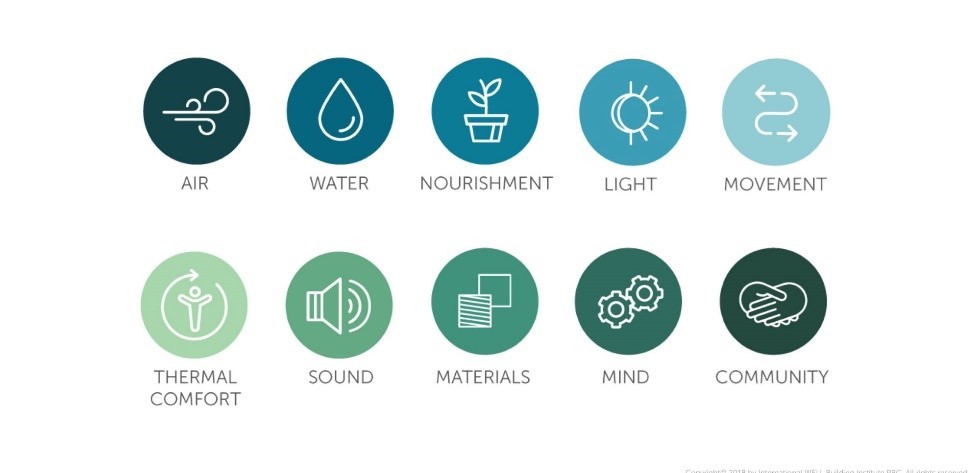edm WELcomes WELL
July 1st, 2021

Learn more about edm's sustainability initiative in the second part of our sustainability series: Healthy Buildings and WELL.
What are Healthy Buildings?
Healthy buildings are those that “promote the physical, psychological, and social well-being of people in buildings and the built environment”. Some of the benefits of having a healthy building include increased worker productivity and function, increase in rent of the space or occupancy, and reduction of sick time of the occupants.Right now, many studies are being conducted on this topic, and several rating systems and certifications emerged to promote the construction and design of healthy buildings.
At edm, our team of architects, designers, and engineers wants to bring human experiences to the next level and instead of creating the usual interiors with highly used systems and designs use those that will be making everyone feel welcome and comfortable in their indoor environment. Because we like to pioneer in technology and innovation, edm is starting the task of transforming their offices into Well Certified Interior spaces.
What is WELL?
WELL is a building standard that creates better, healthier buildings, and is aimed at increased health, physical and social, and comfort of the occupants. It encompasses 10 concepts: air, water, nourishment, light, movement, thermal comfort, sound, materials, mind, and community. Since people spend about 90% of their time indoors, the concepts aim at making the time spent there enjoyable, pleasurable, and unharmful.
- Air – aims to achieve a high level of indoor air quality throughout the building’s lifetime through creating a smoke-free environment both outdoors and indoors, improving ventilation design, construction pollution management, and microbe and mold control using UVGI systems.
- Water – aims to manage quality and distribution of water in the buildings through recommending placement of water indicators, managing the water quality and being transparent about it, promoting human hydration, supporting hygiene, and implementing the concept of basic water management.
- Nourishment – promotes the availability of fruits and vegetables in facilities that provide food, and also promotes nutritional transparency through promoting healthy eating, providing alternative options for people with dietary restrictions, and providing space for meal-prep on-site, with eating, handwashing, and food storage facilities included.
- Light - promotes exposure to natural light and creates lighting environments that promote visual, mental, and biological health. Typically, the natural lighting and circadian rhythms issues can be solved in tandem by, for example, limiting occupied spaces to the perimeter of the space or providing skylights, light shelves, or similar lighting means, by selecting lighting fixtures that mimic natural light or those that adjust the color temperature throughout the day. Similarly, the glare control and individual lighting issues can be solved in tandem as well by, for example, installing shielded fixtures or providing task lighting and installing lighting zones.
- Movement - aims to promote physical activity through environmental design, policies, and programs through the presence of staircases and pedestrian-scaled elements, signage, provision of alternative sitting that also allows standing, provision of bike storage, showers, and lockers, and provision of workspace wellness programs.
- Thermal comfort - aims to promote human productivity through improved HVAC system design and control through encouraging the use of personal heaters, human-centric zoning, humidity control, and monitoring thermal comfort parameters.
- Sound - concentrates on identification and mitigation of acoustical comfort through creating sound map areas to help separate loud and quiet zones, replace hard surfaces with sound-absorbing ones, and managing the impact noise by preventing sound transmission through the structure and utilizing concrete construction when possible.
- Materials – aims to reduce human exposure to chemicals through restricting knowingly hazardous materials, remediating sites that are known to be contaminated, managing lead content, managing interior hazardous materials, restricting VOCs, and managing construction waste.
- Mind - promotes mental health through factors that influence cognitive and emotional well-being through the introduction of the natural environment to the indoors through indoor plants and views outdoors, provision of break spaces, and provision of access to nature, when possible.
- Community - focuses on encouraging diversity, equity, and justice for all community members through providing services and benefits, promoting health and wellness, conduction of occupancy surveys, providing family support, encouraging civic engagement, executing responsible labor practices, and supporting victims of any kind of abuse or trauma.
Through combined efforts of team members with different backgrounds, education, talents, and experiences, edm’s team is striving to produce designs that will be enhancing the lives of as many people as possible, without sacrificing design for functionality and quality.









